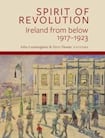
There was a widespread revolutionary spirit in Ireland during the independence struggle, which comprised demonstrations, strikes, cattle drives and seizure of agricultural and industrial property, but which has received little attention in the historiography of the period. It manifested itself in action “from below”, ie, carried out by ordinary workers, especially agricultural labourers, in many parts of the country. This collection of regional and local case studies explores the mass mobilisation that occurred.
Among some specific issues considered are the actions of miners, carters, farmers, business and professionals associated with the Castlecomer coalfield in Co Kilkenny, where notions of freedom were contested and labour’s interests weren’t a priority; agrarian agitation throughout Co Galway in spring 1920, which contributed significantly to increased land redistribution; how the United Irish Plotholders’ Union (“plots” were allotments) campaigned for and got better conditions for its members; the activities of the Moygownagh IRA (north Mayo), where they protected graziers’ interests rather than satisfying smallholders’ land hunger. Moira Leydon, author of the essay on the mobilisation of agricultural labourers in Maugherow, Co Sligo, had no doubt that the radicalisation of the rural proletariat in the syndicalist, anti-imperialist and republican ITGWU was a microcosm of the Irish revolution.
More general issues explored are the establishment of “soviets” in Galway city and parts of Munster, and the involvement of women activists in Kerry and in the Irish Trade Union Congress (ITUC). In Galway, the Town Tenants’ League, frustrated at the housing situation, occupied the council chamber and selected “people’s” councillors and justices, toppled the statue of Lord Dunkellin in Eyre Square and dumped it in the sea. The Munster soviets were much more well-organised and long-lasting affairs, posing a serious threat to employers and the trade-union leadership alike – a Munster Council of Action was established, guided by Marxist organisers, and demanded immediate revolutionary action, which proved too fragmented to be effective.
The analysis of women’s involvement looks at woman union activists, political and military women and the individual revolutionary Gobnait Ní Bhruadair – all in Kerry – and women activists in the ITUC 1916-23, where they insisted, “by both their presence and participation ... on their integration into Irish labour and society as equals”.
Trinity Library showcases modern greats
Slow Train Coming by Todd Almond: The inside story of Bob Dylan and Conor McPherson’s stage collaboration
Children’s fiction: Five books to delight the younger reader with tales of magical cats, geese and squirrels - and a busy girl called Wanda
Filthy Queens: A History of Beer in Ireland – A quaffable and comprehensive history that leaves the reader with a thirst for more
Valuable local-history studies such as these greatly extend our understanding of the independence struggle.













